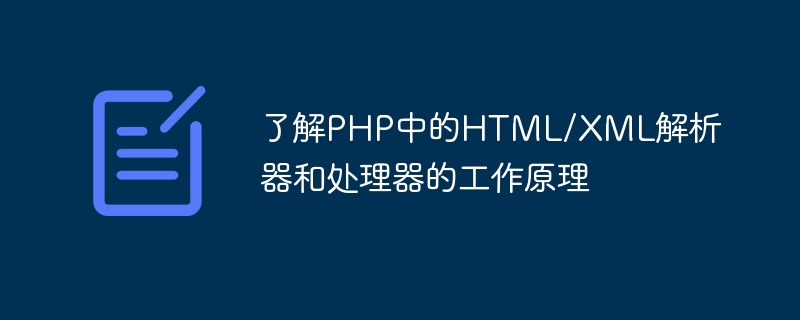Home >Backend Development >PHP Tutorial >Understand how HTML/XML parsers and processors in PHP work
Understand how HTML/XML parsers and processors in PHP work
- WBOYWBOYWBOYWBOYWBOYWBOYWBOYWBOYWBOYWBOYWBOYWBOYWBOriginal
- 2023-09-10 14:09:141011browse

Understand how HTML/XML parsers and processors in PHP work
HTML/XML parsers and processors are used in many web development projects Important tool. They are responsible for parsing and processing HTML or XML documents so that they can be read and manipulated by server-side scripts such as PHP. Understanding how they work is crucial for developers. In this article, we will take a deep dive into how HTML/XML parsers and processors work in PHP.
First, let us understand how the HTML/XML parser works. HTML/XML parsers are responsible for breaking down HTML or XML documents into structured data so that they can be easily read and processed by other programs or scripts. It does this by identifying and parsing tags, elements, and attributes in documents.
The working process of the parser can be divided into the following steps:
- Lexical analysis: The parser first decomposes the document into individual tags. A tag is the smallest unit in a document, which can be a start tag, end tag, attribute, or text content.
- Syntactic analysis: In this stage, the parser organizes the tokens into a tree structure to represent the structure of the document. This tree structure is called a parse tree or syntax tree.
- Semantic analysis: The parser converts the parse tree into an internal representation more suitable for processing. It verifies that the structure and syntax of the document are correct and makes any necessary corrections or modifications.
Once the document has been parsed into structured data, it can be read and manipulated using a processor. The processor can perform various operations based on the developer's needs, such as reading markup content, modifying the document structure, adding new elements or attributes, etc.
In PHP, you can use various built-in functions and classes to process HTML/XML documents. The following are some commonly used processor tools:
- DOM (Document Object Model): DOM is one of the most commonly used HTML/XML processors in PHP. It allows developers to use an object-oriented approach to read, modify, and add elements and attributes in documents. DOM provides a set of powerful APIs that make it easy to operate complex HTML/XML documents.
- SimpleXML: SimpleXML is another HTML/XML processor for PHP that provides a simple and intuitive way to read and manipulate XML documents. Developers can use a series of functions and methods of SimpleXML to access the data in the document and perform corresponding operations.
- SAX (Simple API for XML): SAX is an event-driven HTML/XML processor. It handles tags and events in the document through callback functions. SAX does not require the entire document to be loaded into memory, so it is suitable for processing large XML documents. Developers can define their own callback functions and perform corresponding operations during the parsing process.
In addition to the commonly used HTML/XML processors mentioned above, there are other less used tools, such as XMLReader and XMLWriter. These tools may be more applicable in certain scenarios.
To summarize, it is crucial for developers to understand how HTML/XML parsers and processors work in PHP. Parsers are responsible for breaking down HTML or XML documents into structured data, while processors allow developers to read and manipulate this data. In actual projects, developers can choose appropriate tools for processing according to their needs.
The above is the detailed content of Understand how HTML/XML parsers and processors in PHP work. For more information, please follow other related articles on the PHP Chinese website!

